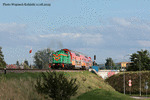 SM42-523-2025_08_11.jpg (150312 bytes)
SM42-523-2025_08_11.jpg (150312 bytes)|
The Railfaneurope.net Picture Gallery
Directory: /pix/new/10_oct02
Last update: Sun 30 Nov 15:46:57 GMT 2025
|
|
Polregio SM42-523 with the passenger train Gdynia Glowna - Hel 11.08.2025, track Reda - Reda Rekowo Photo W. Kolins |
|
Baltycki Serwis Kolejowy (BSK) SM42-2108 18.07.2025, Scinawka Srednia Photo W. Kolins |
|
Baltycki Serwis Kolejowy (BSK) SM42-2108 18.07.2025, Scinawka Srednia Photo W. Kolins |
|
Kolej Baltycka (KB) SM42-2108 22.11.2014, Wejherowo Photo W. Kolins |
|
Pomorskie Przedsiebiorstwo Mechaniczno-Torowe (PPMT) SM42-2122 04.02.2014, track Skowarcz - Rozyny Photo W. Kolins |
|
Pomorskie Przedsiebiorstwo Mechaniczno-Torowe (PPMT) SM42-2122 16.12.2014, Gdansk Zaspa Towarowa Photo W. Kolins |
|
Pomorskie Przedsiebiorstwo Mechaniczno-Torowe (PPMT) SM42-2122 07.04.2016, Wejherowo Photo W. Kolins |
|
Pomorskie Przedsiebiorstwo Mechaniczno-Torowe (PPMT) SM42-2122 07.04.2016, Wejherowo Photo W. Kolins |
|
Pomorskie Przedsiebiorstwo Mechaniczno-Torowe (PPMT) SM42-2122 07.04.2016, Wejherowo Photo W. Kolins |
|
Pomorskie Przedsiebiorstwo Mechaniczno-Torowe (PPMT) SM42-2122 20.04.2016, track Wejherowo - Goscicino Wejherowskie Photo W. Kolins |
|
Pomorskie Przedsiebiorstwo Mechaniczno-Torowe (PPMT) SM42-2122 18.11.2020, track Orneta - Lubomino Photo W. Kolins |
|
Pomorskie Przedsiebiorstwo Mechaniczno-Torowe (PPMT) SM42-2122 18.11.2020, track Orneta - Lubomino Photo W. Kolins |
|
Pomorskie Przedsiebiorstwo Mechaniczno-Torowe (PPMT) SM42-2122 18.11.2020, track Orneta - Lubomino Photo W. Kolins |
|
Konstal 805Na No. 275 and 283 on route 6 before stopping at Chodkiewicza/Paderewskiego, Bydgoszcz, Poland, 19.09.2025.
Photo by Michal Kozicki (michalmarekkozicki@gmail.com) |